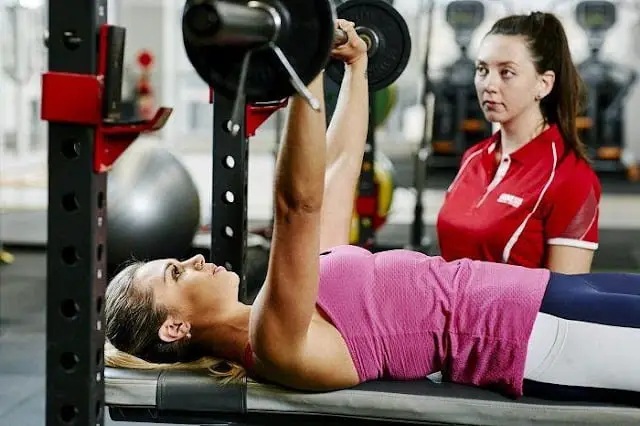As a beginner, you’ll believe about anything anyone tells you. Just like a little kid will believe the bogeyman is under his bed, he’s uneducated in separating fictional from nonfictional, so, therefore, he often is misleading and is willing to believe whatever those whom he may consider intelligent says. A weight lifter is no different, they’ll believe supplements do all the work and barbell training does the rest. No one in fact believes the key to proper success – nutrition, training, and rest.
Spread Your Love
Those are all you need, you don’t need supplements and you don’t need every day in the gym. One of the biggest myths there is the misinformation posted regarding muscular hypertrophy occurs while training in the gym. The first thing I’m going to address is imbalance prevention in a program.
Pushes and pulls are the two predominant forces the body is designed to use. If you push something, you are using a certain set of muscles – predominantly the anterior deltoids and triceps as synergists and the chest/pectoralis major as the agonist. This would make the antagonists the biceps, posterior deltoids, and the lats. If one of these is worked or overactive in comparison to the opposing antagonist, the imbalance is the result. This is a sport where this is not the goal, it’s funny hearing how powerlifters are recommending beginners to disregard the use of opposing pulls when their rotator cuff injuries stack up as they begin neglecting horizontal/vertical pulls.
Read more:
Strength is only carried in one definition – a muscle’s ability to generate maximal force in a single contraction. This doesn’t mean if you are strong at deadlifting, you will be at everything else. I would love to see someone who performs pull-ups and deadlifts each “pull” or “back” session and compare their lat/pullup strength with the person that only performs deadlifts. I would also like to compare the shoulders of someone who religiously performs horizontal pushes and neglects the horizontal pull with someone that performs both motions. If your body was designed to push something, it was designed to pull it too.
It brings me to my point that the exact reverse is the guide and key to imbalance prevention. If you rely solely on barbells curl and neglect skull crushers the elbow will become imbalanced. The way to note this at the beginning of the severity is simply by seeing how the ulna/radius separates from the humerus. What I mean by this, is the developed tricep (balanced) should pull the ulna and the radius somewhat down to a more extended than flexed position. If the ulna and radius try to come up when relaxed, it’s due to an overactive bicep and underactive triceps. The way to fix this is by performing skull crushers/triceps extensions at the same or at a greater frequency than barbell curls or other elbow flexor developmental exercises.
Performing the exam reverse is the most promising way to work an antagonist’s muscle and balance an exercise. It’s no different than with bench presses and barbell rowing, it’s no different than with hanging leg raises and sit-ups in comparison to deadlifts.
Each movement can be potentially dangerous, provided the exact reverse is neglected. Reversing the force in the same plane is going to predominantly work the exact muscles. Extension of the knee predominantly works the quad muscles while flexion of the knee will predominantly work the hamstrings. They are complete opposites and it brings the benefit of antagonistic training.
It’s often hypocritical hearing powerlifters also recommending everyone to squat when the reverse force is neglected – knee flexion. It’s no different, while the quads should probably be given more attention than the hamstrings due to size differences, you would want to keep them in proportion, which is what balanced training is.
Your routine should consist as a beginner of only must needed exercises, don’t focus on barbell curls, focus on chin-ups…don’t focus on fly’s, focus on bench presses…don’t focus on lateral raises .focus on overhead pressing, get me? Your joints weren’t designed to be isolated from one another, they were designed to produce force together. You won’t increase your vertical jump by performing leg extensions.
Your quads are being worked in an isolation from the hamstrings/glutes in a leg extension when performing an everyday activity they are designed to work together, creating coordination and the hormonal response is reflective of this. It brings me back to my “Compound Movement Training” routine that is posted on my signature…but gaining mass is all in the nutrition, which I will go into more detail in this article.
I would first like to clear up a few errors people make in designing an exercise program. If you work a certain push, always work the opposing pull. This will help balance your joints and muscles, it will also give you more functional strength (potential carryover) into other exercises.
I’m going to list several routines I feel beginners should take into consideration when contemplating a solid program. I’m also going to provide a video demonstration of certain lifts. Please be patient with this article, it makes take several weeks as I’m only going to work on it
late at night. But when it’s finished it should definitely guide you in the right direction. There’s absolutely no doubt a beginner should focus on growing as a whole, their joints need to learn to coordinate together before they learn to isolate, their body doesn’t need isolated…it needs to grow as a whole and this is done through big compound movements. Let’s first define a compound movement…a compound movement is a movement recruiting multiple joints to perform.
An isolation movement is a movement that isolated a specific joint to strengthen it without the demand for overload to supporting and secondary muscle groups. An example of a compound movement for the chest is the bench press, an example of isolation for the chest is a fly.
You should focus on a progressive overload of a bench press before you should consider isolating it with fly’s. Only when overload cannot be met through resistance, tempo, volume, or other forms of intensity should isolations be considered to increase overload.
Strength training tips for beginners:
Let’s start with the necessary movements for a beginner program. Let’s then balance those movements. Only the major muscle groups need to develop in the first stage of training, proper form should be the #1 priority.
By learning good form, you are programming good motor patterns and teaching your body correct technique (which can only be done through free weights) as the peripheral system will send the CNS impulses through the spine teaching it the movement it would just present to. Which is a reason why free weights are so superior, they are natural motions, machines that cancel utilization of stabilizers are not.
There are quite a few movements needed for a beginner program, although these movements should only be progressed with if the form is first down.
Necessary Movements:
(1) Deadlifts:
(2) Back Squats:
(3) Glute/Ham Raises:
(4) The Press:
(5) The Pullup:
(6) Bench Press:
(7) Barbell Row:
Accessory Exercises:
(8) Hanging “Weighted” Leg Raises:
(9) Parallel Dips:
(10 Lunges:
(11) Barbell Curls:
(12) Skull Crushers:
Those are the only exercises needed for a beginner program. Focus on an overload of those movements, increase them every workout that is possible. Next, I’m going to get into some cardio detail and routine design detail.
Newbie Gains:
Linear progression can be witnessed through beginner specificity training. They call it “linear based programs”, this is because the routine is based to allow constant progression for compound movements. Why is it that a beginner can do this and advanced and intermediate athletes cannot? Well, it’s because when a muscle is new to overload, it demands that previously inactive motor units be activated stimulating more muscle fibers.
This results in significant increments of muscular strength but not always significant increments of muscular size (remember, strength and specific hypertrophy are not always the same, hypertrophy is determined through calories while strength is not).
All beginners, regardless of previous experience, which brings me to the question – when do you feel you are no longer a beginner? When you bench 2 plates? When you squat 3 plates? When your arms grow to 15″? These are all inaccurate. No specific poundage determined your experience level, each person depended upon their genetic response to specific stimuli will differ and the routine, diet, and cardio style is reflective of this. You are considered to be an intermediate trainee, or no longer a “novice” for a prettier word when you can no longer make
the linear progression to your compound movements. This can differ from each individual. I’ve seen guys enter linear-based programs like starting strength beginning with 95 lb bench presses for low reps and coming out rapping 225. This is no joke, it’s all dependent upon how you take advantage of this to its full potential. Focus on your linear increments, always.
Nutrition:
The most underestimated factor in determining significant hypertrophy is indeed the caloric intake. Your body doesn’t build muscle through the anaerobic glycolysis byproduct (lactic acid) as people as under the misconception that the pump they feel during workouts is muscle growth. Your body must have something to build from, it builds through nutrients. Remember, muscle isn’t weight-less and I don’t care how strong you get you will not get bigger without eating over your maintenance calories. Unless you are some type of genetic freak of nature with newbie gains that are coming with hypertrophy as a bonus.
Your caloric intake is depended upon a variety of factors – your metabolism, activity level, temperature, humidity, body composition, and a variety of other things. You cannot build muscle from nothing, there has to be something to create something. Your caloric intake should be based on as follows:
- 12-30% of protein
- 50-65% of carbohydrates
- 20-40% of fats
Your intake during hypertrophy-specific oriented cycles should be as follows – carbohydrates as the highest nutrient, fats as the next highest, and protein as the last. I’ll be writing another short brief article on why protein is the least important nutrient and how a surplus in protein can serve as counterproductive.
Cardio:
During bulking phases, I recommend HIIT; however, during cutting phases, it depends on the length you’ve been cutting. In the first month of a cutting phase I recommend HIIT to rid any extra glucose in the muscles, this alone will result in a leaner look due to the loss of water weight.
Glycogen (the stored form of glucose) is a polar molecule; it stores excessive amounts of water. The first-month stick with HIIT or Tabata, once you rid your extra water weight stick with lower intensity cardio so that you are burning fat and not glucose during your cutting phase. You could also mix it up.
The routine:
Workout A:
- Barbell Full Squat
- Flat or Incline Bench
- Barbell or T-Bar Row
- Stiff-leg deadlift or power clean
- Weighted Dips (optional)
Workout B:
- Barbell Full Squat
- GHR
- Standing Barbell Press
- Weighted Pull-up, Chin-Up or Pulldown
- Weighted Leg Raises (optional)
Extra tips:
Flat benches are good for upper body overall strength; it can also cause protracted shoulders. So with this in mind, once you get to the point where you can perform about 20 parallel dips in a single set, I recommend then replacing flat benches with parallel dips and performing incline benches and weighted parallel dips (with the head leaning forward).







